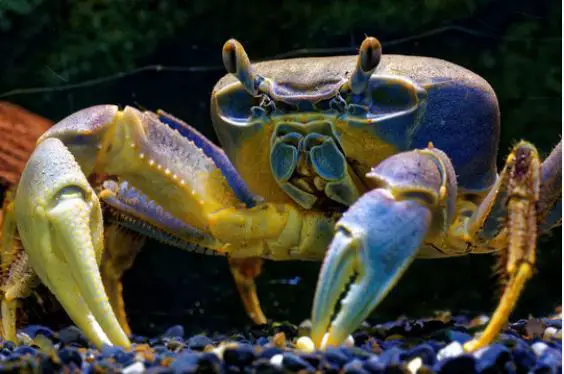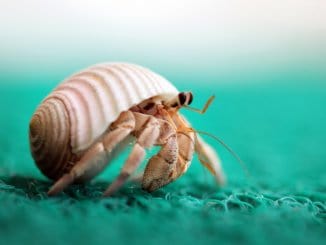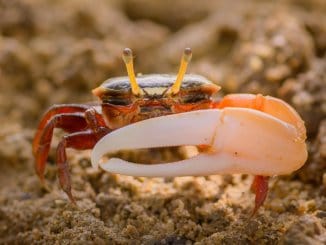
Rainbow Crabs are fascinating pets because they are not fully aquatic, so you get to enjoy them both in the water and on land!
They are also stunning to look at, with their bright colors and eyes that look like goggles.
Although Rainbow Crabs are not super difficult to care for, they do need to have a dedicated tank, and they’ll need a paludarium or a tank that features aquatic and terrestrial elements.
We’ve gathered all the information you’ll need to properly care for your Rainbow Crabs. We’ll cover things like their behavior, optimal tank conditions, diet, and much more.
TABLE OF CONTENTS
Rainbow Crab Facts & Overview

| Category | Rating |
| Care Level: | Easy-medium |
| Temperament: | Aggressive |
| Color Form: | Purple-blue carapace and orange-red legs |
| Lifespan: | Up to 8 years |
| Size: | 3-4 inches |
| Diet: | Omnivore |
| Family: | Gecarcinidae |
| Minimum Tank Size: | 20 gallons (for a single crab) |
| Tank Set-Up: | Paludarium |
| Compatibility: | Not compatible with other species |
The Rainbow Crab, scientific name Cardisoma armatum, is also known as the African Rainbow Crab, Nigerian Moon Crab, and the Patriot Crab. They originate in Africa’s West Coast. The little creatures are super scrappy and will attack their own, so they’ve earned the moniker “Soapdish Crabs” because they have to be packed in soap dishes for transport to the pet store.
They grow to about 4 inches (12 cm) in size, although some have been known to get to 8 inches (24 cm). They can live up to 8 years, and if you’re keeping them in captivity, be mindful of their natural environment — in the wild, for example, females must go back to the ocean to lay their eggs, so breeding in captivity is not a good idea (more about that later.)
Fun fact: Rainbow Crabs are not the only crabs called Soapdish Crabs and Moon Crabs, so they’re often confused with other species.
Typical Behavior
Typical of crabs, Rainbow Crabs are solitary creatures and get especially crabby (!) as adults. They’ll fight to the death with their own, and really should be kept alone in a tank. Their claws are super strong and sharp, so be careful with your human skin, since you don’t have a carapace to protect yourself.
They’ll also destroy aquatic and terrestrial plants if they don’t have enough vegetables in their diets.
As we mentioned before, Rainbow Crabs are not fully aquatic and actually spend the bulk of their time on land, where they love burrowing. Not only do the deep burrows provide comfort and security, but they also help the Rainbow Crabs stay in homeostasis with the amount of moisture they need to breathe with their modified gills.
Speaking of burrows, the Rainbow Crab will spend much of the day hiding out in their dug digs, and come out to party on the surface at nightfall. If you’re feeding them during daylight, however, they’ll get accustomed to this schedule and will show up to eat. Keep the lighting dim, though.
Molting
Molting is the means by which Rainbow Crabs increase their size — they molt anywhere from every few weeks to every few months depending on their size and age. They absorb copious amounts of water that causes their upper shell to burst, and then they climb out of the carapace, a process which completes within a half hour.
Clearly, the molting cycle leaves the Rainbow Crab vulnerable, as it is without its hard protective shell. Don’t move or touch your Rainbow Crab during molting. It’s also a good idea to refrain from feeding your Rainbow Crab during this period since they need the nutritional value of the calcium in the discarded carapace.
If you notice your Rainbow Crab lacking energy and declining food, that’s a good sign that the molting process is imminent.
Appearance
Rainbow Crabs live up to their name, and have vivid coloration, particularly when they’re young and after they molt, sporting a carapace that’s purple and blue and legs and claws that are orange and red.
Their color fades before they molt and after they age, and they have a faded yellowish tinge, although you might also see some red spots.
You can distinguish the males from the females because the female has a wider abdomen — hey, she’s growing baby crabs in there. The hue of the males is significantly more striking than that of the female.
We mentioned that their size range in captivity is between 3 and 4 inches (7-12 cm); their weight range is anywhere from 3.4 – 10.25 ounces (96-290 g).
Habitat and Tank Conditions

As detailed before, Rainbow Crabs need a paludarium setup to satisfy their terrestrial and aquatic needs, and they also need freshwater or brackish water.
In the home environment, it’s vital to provide the correct mix of water and land. The Rainbow Crab needs to be able to submerge in water but will drown if they can’t get out of the water.
For the terrestrial part, they need a thick layer of moist sand for burrowing, along with roots, plants, and rocks.
Water and Land Balance: Aim for a 50/50 split of aquatic and terrestrial elements for a thriving Rainbow Crab.
Tank Conditions
Substrate
Rainbow Crabs need moist sand for digging, and they’ll need rocks, roots, and pebbles to help them get in and out of the water. Driftwood or bark would also be a good option.
Pro-tip: The sand should be moist but not dripping water.
If you need to moisten the sand, make sure to use water without chlorine.
Humidity
We mentioned the importance of humidity earlier — because they have modified gills, Rainbow Crabs depend on the humidity for proper oxygenation. Aim for 80% so that your beloved crab won’t suffocate.
Because of the high humidity, you’ll have to attend to any condensation so that you prevent bacteria and fungus growth.
What Size Aquarium Do They Need?
If you’re keeping one Rainbow Crab (which we strongly recommend), you’ll need at least a 20-gallon (90 liters) tank. Double that for one male and one female. If you’re attempting to house two males, go for at least 60 gallons due to territory issues.
The Rainbow Crabs are climbers, so make sure that the habitat you’ve lovingly set up isn’t high enough for them to climb out, and keep the tank tightly sealed.
Water Conditions
Rainbow Crabs do best in freshwater or 5-10% brackish water. If you are using tap water, add a dechlorinator or let the water stand for 24 hours before introducing your Rainbow Crabs.
Warm temperatures are ideal for Rainbow Crabs since that’s what they are accustomed to in their natural habitat. Provide temperatures between 75 and 85 F (23-29 C). Make sure you hide any heating elements and metal cords from the highly effective claws of the Rainbow Crab.
Tank Mates
Anybody you put in a tank with a Rainbow Crab is at risk. They are not social creatures and will attack other Rainbow Crabs, other crustaceans, fish, and mollusks. They’re especially fond of snails and shrimp.
Diet
Rainbow Crabs are omnivores and will pretty much eat whatever you give them, though the bulk of their nutrition comes from fruit, plants, and carrion, or waste.
Calcium is a good supplement to their diet, as are vegetables.
Care
The most important thing you can do for your Rainbow Crab is to make sure they have appropriate water to earth environment that allows them to submerge in water and burrow in the sand.
They need places to hide, even if they’re alone in the tank, and need cover when they’re molting.
Another easy way to make your Rainbow Crab happy is  to ensure they have a dimly lit atmosphere.
to ensure they have a dimly lit atmosphere.
Check the water quality every week and the temperature and filter every day.
You should change 10-25 percent of the water every other week.
Breeding
The idea of breeding Rainbow Crabs in captivity is ill-advised both because of the inability to recreate the ocean to sand experience, and also that Rainbow Crabs mate based on lunar cycles and tides that are impossible to connect within a home tank.
And of course, their penchant for fighting with each other would make mating while living in close quarters highly unlikely.
Nonetheless, we’ll give you some information about how Rainbow Crabs mate in the wild. Reaching sexual maturity when they reach 5 1/2 to 6 inches (14-15 cm), Rainbow Crabs are ready to mate at 3-4 years of age.
The male comes towards the female with his claws outstretched into the air; the female will keep her claws lowered as a sign of acceptance. To decline the offer, the female will attack him with her claws.
After about 90 minutes of foreplay, mating occurs, after which the female Rainbow Crab will carry the fertilized eggs underneath her body for 14-21 days.
The cluster of fertilized eggs is initially orange and then changes to yellow, gray, and then black. When the cluster reaches the black phase, the female Rainbow Crab journeys to the ocean and releases her eggs into shallow waters.
Survival of Rainbow Crab Larvae
In their natural habitat, the female Rainbow Crab lays 300,000 to 4,800,000 eggs. However, only a fraction of the larvae survives, as they are eaten by fish and other ocean dwellers. The larvae that survive the harsh realities of ocean creatures may not survive to crabhood if they drown before they can reach the land.
Rainbow Crab larvae go through six stages of development, and then a final stage, where they finally become tiny crabs. This whole process spans a period of 40-50 days.
Baby Rainbow Crabs return to the mainland and burrow deeply in the moist sand to ensure sufficient oxygen.
Are Rainbow Crabs Suitable for your Aquarium?
Rainbow Crabs are beautiful to look at with their vivid hues and are great creatures for your home paludarium. They’re fairly easy to care for, have a decent life span, and will keep you entertained. How cool to watch them molt and then eat their carapace!
You should remember, though, that there are some peculiarities involved in welcoming Rainbow Crabs into your hobby. They don’t do well with others, so you’ll likely need a second tank. You also want to make sure you have a tight-fitting tank so that your crabs don’t injure themselves if they’re trying to explore outside their tank.
If you’re looking for a social aquarium with many inhabitants, the Rainbow Crab may not be for you. But if you’re happy with just you and your crab, the Rainbow Crab just might be exactly what you’re looking for!
Are Rainbow Crabs your ideal pet? Let us know why in the comments below…







can they be taken out of their cage to walk around? can you hold them or play with them a little?
also i used to have a pet tarantula and to keep its cage at high humidity i would spray it down with a water spray, for high humidity should i replicate this?